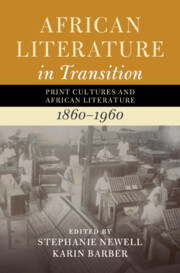Refine search
Actions for selected content:
723 results
28 - Religion and Poetry in Australia
-
-
- Book:
- The Cambridge History of Australian Poetry
- Published online:
- 19 November 2025
- Print publication:
- 11 December 2025, pp 523-537
-
- Chapter
- Export citation
Imagining the Lūṭī and the people of Lūṭ
-
- Journal:
- Journal of the Royal Asiatic Society , First View
- Published online by Cambridge University Press:
- 14 November 2025, pp. 1-25
-
- Article
-
- You have access
- Open access
- HTML
- Export citation
Introduction
-
-
- Book:
- African Literature in Transition
- Published online:
- 23 October 2025
- Print publication:
- 06 November 2025, pp 1-12
-
- Chapter
-
- You have access
- HTML
- Export citation
Chapter 20 - Print and the Question of Literature in Islamic West Africa
- from Part IV - Worlds of Print
-
-
- Book:
- African Literature in Transition
- Published online:
- 23 October 2025
- Print publication:
- 06 November 2025, pp 392-408
-
- Chapter
- Export citation
13 - Freedom of Thought, Conscience and Religion
-
- Book:
- Human Rights Law in the UK
- Published online:
- 11 November 2025
- Print publication:
- 30 October 2025, pp 700-763
-
- Chapter
- Export citation
Chapter 4 - The Imperial Cosmopolis
-
- Book:
- The Roman Empire and World History
- Published online:
- 31 October 2025
- Print publication:
- 30 October 2025, pp 86-118
-
- Chapter
- Export citation

African Literature in Transition
- Print Cultures and African Literature, 1860–1960
-
- Published online:
- 23 October 2025
- Print publication:
- 06 November 2025
6 - Minority Religious Movements
- from Part II - Religious Traditions
-
- Book:
- Civil Religion and the Renewal of American Politics
- Published online:
- 09 October 2025
- Print publication:
- 23 October 2025, pp 104-132
-
- Chapter
- Export citation
Cosmopolitan Spirits: Islam and the Experimental Cosmologies of Egypt’s Spiritualist Movement, 1947–1960
-
- Journal:
- Comparative Studies in Society and History , First View
- Published online by Cambridge University Press:
- 09 October 2025, pp. 1-26
-
- Article
-
- You have access
- Open access
- HTML
- Export citation
10 - ‘Grenada Ain’t Far from Africa’
-
- Book:
- The Yoruba Are on a Rock
- Published online:
- 18 September 2025
- Print publication:
- 09 October 2025, pp 313-335
-
- Chapter
- Export citation
Chapter 3 - Women Travellers
- from Part I - Contexts
-
-
- Book:
- The Cambridge Guide to Global Medieval Travel Writing
- Published online:
- 03 October 2025
- Print publication:
- 02 October 2025, pp 57-72
-
- Chapter
- Export citation
Chapter 32 - Mecca
- from Africa and the Middle East
-
-
- Book:
- The Cambridge Guide to Global Medieval Travel Writing
- Published online:
- 03 October 2025
- Print publication:
- 02 October 2025, pp 568-586
-
- Chapter
- Export citation
11 - Islamic Receptions
- from Part II - The Christological Reception
-
-
- Book:
- The Cambridge Companion to Christology
- Published online:
- 15 September 2025
- Print publication:
- 02 October 2025, pp 180-198
-
- Chapter
- Export citation
From the Time of Ignorance to the Afterlife: Gendered Chronotopes and Religious Nostalgia in Swahili-Language Islamic Marital Booklets
-
- Journal:
- Signs and Society ,
- Published online by Cambridge University Press:
- 18 September 2025, pp. 1-17
-
- Article
-
- You have access
- Open access
- HTML
- Export citation
Chapter 11 - Religion
- from Part II - Themes and Issues
-
-
- Book:
- The Cambridge Companion to Modernist Theatre
- Published online:
- 28 August 2025
- Print publication:
- 11 September 2025, pp 198-216
-
- Chapter
- Export citation
Instrumentalising Islam: The religious soft power strategies of China, Russia, and the US
-
- Journal:
- Review of International Studies , First View
- Published online by Cambridge University Press:
- 22 August 2025, pp. 1-19
-
- Article
-
- You have access
- Open access
- HTML
- Export citation
Postface
-
- Book:
- Performing Justice in the Later Roman Empire
- Published online:
- 07 August 2025
- Print publication:
- 21 August 2025, pp 114-117
-
- Chapter
- Export citation
4 - “When You Think about Climate Change, It Is a Social Justice Issue”
- from Part I - Movement Politics
-
-
- Book:
- Stability and Politicization in Climate Governance
- Published online:
- 07 August 2025
- Print publication:
- 21 August 2025, pp 49-62
-
- Chapter
-
- You have access
- Open access
- HTML
- Export citation
11 - Islam as a Christian Heresy
- from Part II - Case Studies
-
-
- Book:
- The Cambridge Companion to Christian Heresy
- Published online:
- 17 July 2025
- Print publication:
- 31 July 2025, pp 215-232
-
- Chapter
- Export citation
Cooking Shows as Gender Edutainment in Authoritarian Regimes: Recipe for (New) Turkey
-
- Journal:
- Politics & Gender , First View
- Published online by Cambridge University Press:
- 04 July 2025, pp. 1-30
-
- Article
-
- You have access
- Open access
- HTML
- Export citation
